RELG 433 - Biblical Archaeology
Course Notes
The Early Bronze Age in Egypt
Images in the text are linked to larger photos - click on them to see the larger pictures.
Hover the mouse over the images to see their captions and copyright credits.
 Pharaohs of the early Dynasties of Egypt
Pharaohs of the early Dynasties of Egypt
The land was unified under one ruler, usually referred to as Narmer, sometimes as Menes (probably different names for the same person), ca. 3100 BC. Several artefacts from that period show a king, identified as Narmer, victorious over his enemies, and wearing one or other of the crowns of Egypt. Before Narmer, Upper Egypt (in the south) and Lower Egypt (in the north) were separate lands, each with its own distinctive headgear or crown.
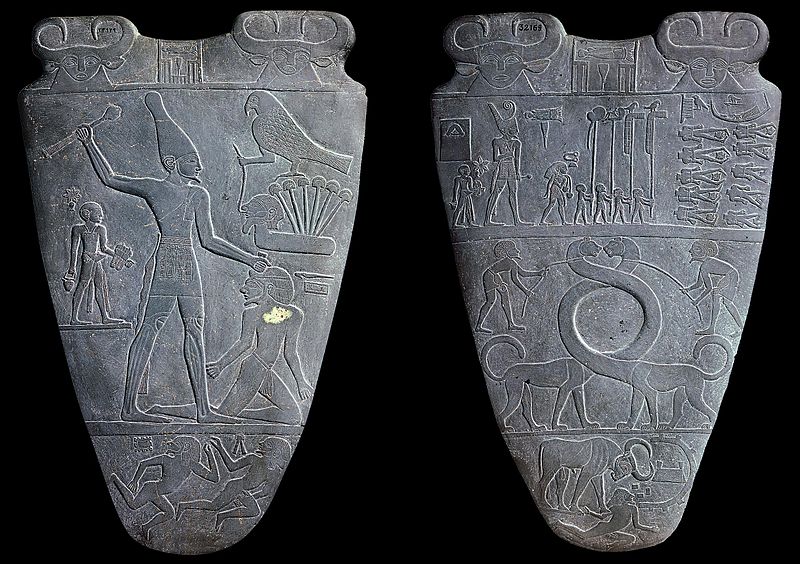 The Narmer Palette (a stone ornament with an indentation for mixing something - cosmetics?) shows, on one side, Narmer wearing the crown of Upper Egypt, and on the other side, Narmer wearing the crown of Lower Egypt while smiting one of his enemies.
The Narmer Palette (a stone ornament with an indentation for mixing something - cosmetics?) shows, on one side, Narmer wearing the crown of Upper Egypt, and on the other side, Narmer wearing the crown of Lower Egypt while smiting one of his enemies.
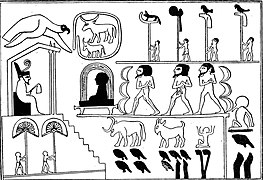
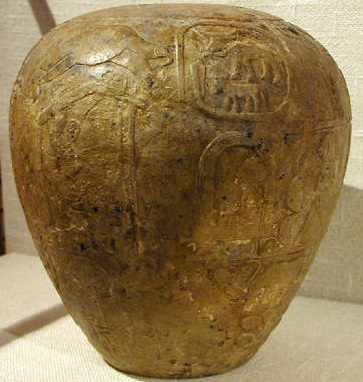 The Narmer mace head shows him wearing the crown of Lower Egypt while reviewing captives and plunder from some campaign. That mace head might just be the same one shown in the Narmer Palette.
The Narmer mace head shows him wearing the crown of Lower Egypt while reviewing captives and plunder from some campaign. That mace head might just be the same one shown in the Narmer Palette.
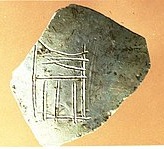 Narmer controlled part of Canaan, as shown by inscriptions bearing his name in Canaan.
Narmer controlled part of Canaan, as shown by inscriptions bearing his name in Canaan.
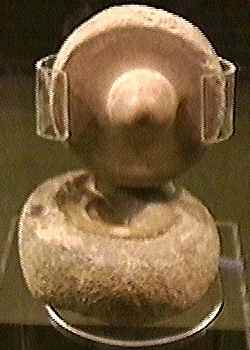 Egyptian influence in Canaan seems to have waned after the reign of Narmer, although there is evidence for continuing trade as far as Beersheba.
Egyptian influence in Canaan seems to have waned after the reign of Narmer, although there is evidence for continuing trade as far as Beersheba.
The Potter's wheel was developed, and spread throughout the ancient Near East.
Forms of writing were developed.
The time of Narmer and his immediate successors (ca.3150-2686 BC) is known as the Early Dynastic period of Egypt (First and Second Dynasties).
The Old Kingdom of Egypt is the period ca. 2686-2100 BC - this includes the Third to the Sixth Dynasties and is the period during which the pyramids were built.
The Egyptian rulers continued to organize the country and the religion along strongly authoritarian lines. The King had control of the land, the labor forces, and the resources, and was regarded as a deity after his death. There was a centralized administration, with educated scribes for collecting taxes, keeping records, drafting peasants to work on irrigation and other building projects, and administering justice. The Temples were used, not only for worship, but also as storehouses for grain for distribution to the people. There was no coinage at that time - laborers were paid in grain or in standard weights of copper or silver. As the administration became larger and more complex a ruler would appoint a "vizier" as his second-in-command; it was such a position that Joseph held many centuries later (Gen. 41:39-44, 48, 55-5)
The class system which eventually developed was strongly stratified - the King was at the top, then an upper class of nobles, bureaucrats, and scribes, who wore white kilts; below them were physicians and engineers, then artists and craft workers (who were controlled by the administration and worked for the temples), then farmers, lastly servants and slaves.
The staple foods for most of the Egyptians were bread and beer - both made from barley and other grains. The grain was harvested by hand, using sickles (first of flint, later of copper or bronze); then it was threshed by beating with a flail - and later a flail became part of the royal regalia of the rulers. The grain was winnowed to remove chaff, then it was ground by hand to flour for bread, or allowed to ferment for beer, or put into storerooms for later use. Their diet was enriched by vegetables (leeks, garlic, legumes, squash (Numbers 11:5) and fruit (dates, figs, and grapes, which were also used for wine). Meat was obtained by hunting ducks and other waterfowl along the Nile, and there was a good supply of fish in the river. Bees were domesticated, and produced both honey and wax. Donkeys and oxen were used, but the horse was not introduced into Egypt until later (when the Hyksos invaded, they brought the horse and the spoked wheel). Camels were an even later introduction. The Egyptians appear to have been among the first to keep animals as pets - even to the extent of mummifying them to accompany their owners into the next life - not only cats, dogs, and monkeys, but also ibexes, birds, and big cats.
Flax was grown for linen, and papyrus was harvested from the banks of the Nile - some of the modern workshops in Egypt still use the methods of soaking, layering strips of papyrus over each other, and pounding them that were developed in ancient Egypt.
Although Egypt had supplies of copper ores, particularly in the Sinai, for making bronze they also needed tin - this had to be imported from Anatolia, so a system of trade routes around the eastern Mediterranean developed.
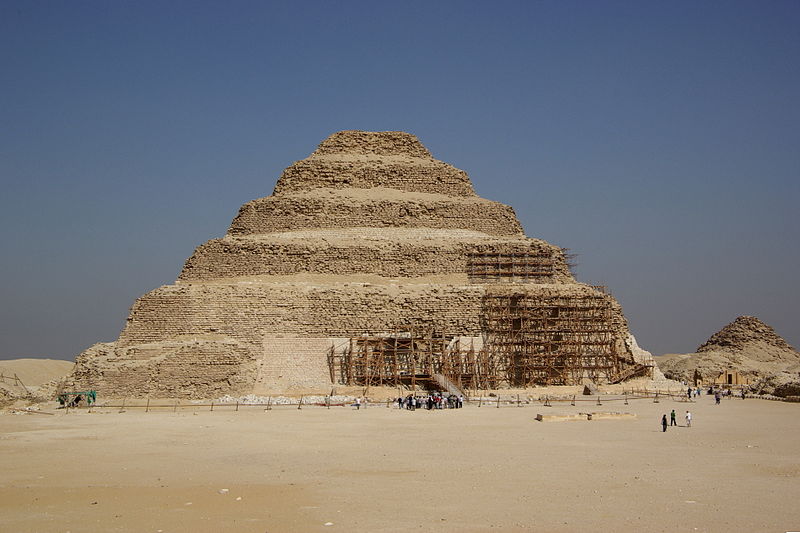 Djoser (ca.2650 BC) was the probable founder of the Third Dynasty in Egypt, and he probably reigned for about 30 years. Inscriptions in the Sinai commemorate Djoser's military campaigns and expeditions to mine copper and turquoise.
Djoser (ca.2650 BC) was the probable founder of the Third Dynasty in Egypt, and he probably reigned for about 30 years. Inscriptions in the Sinai commemorate Djoser's military campaigns and expeditions to mine copper and turquoise.
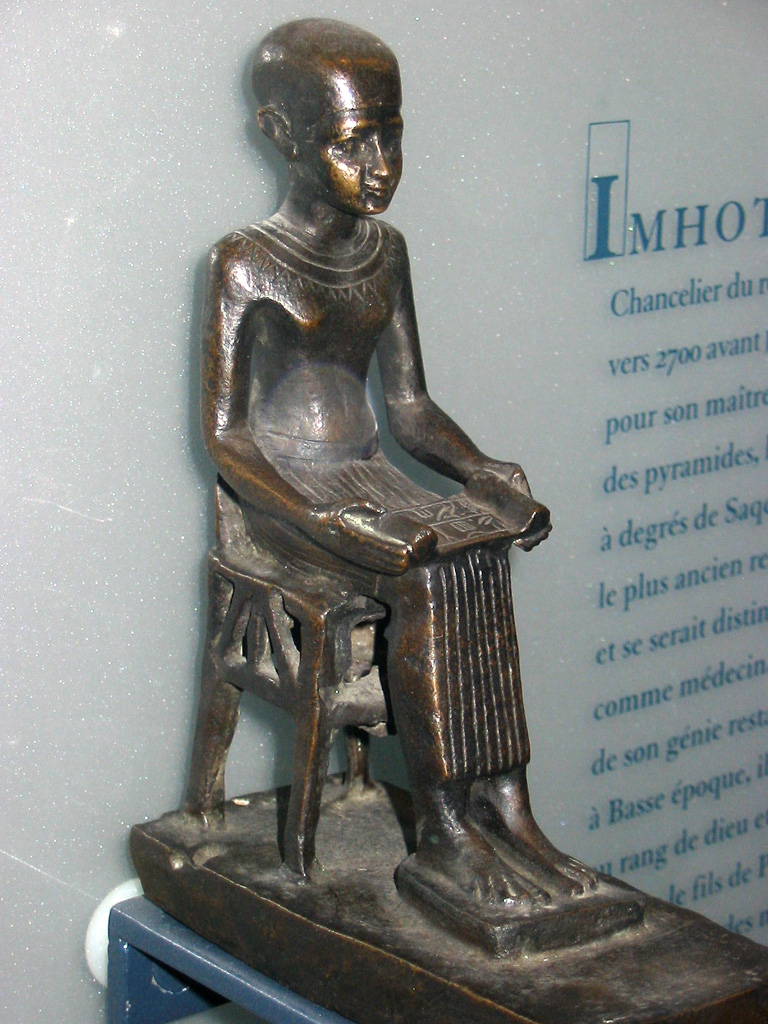 Djoser and his architect and vizier Imhotep undertook many building projects, including the Step Pyramid at Saqqara, where Djoser was buried. This was the forerunner of the later pyramids of Giza. Djoser's Step Pyramid evidently started as a mastaba - the platform-shaped funerary mounds built of mud-bricks which were used for earlier burials. It then had five other mastabas piled on top of it, getting smaller as they got higher. Djoser's pyramid was one of the first large buildings in Egypt to be built of stone rather than mud-brick. Beneath the pyramid was a maze of tunnels, chambers and tomb shafts for members of the royal family and their grave goods. The size and scope of Djoser's building projects shows that by this time the King had control of a vast labor force and large supplies of materials.
Djoser and his architect and vizier Imhotep undertook many building projects, including the Step Pyramid at Saqqara, where Djoser was buried. This was the forerunner of the later pyramids of Giza. Djoser's Step Pyramid evidently started as a mastaba - the platform-shaped funerary mounds built of mud-bricks which were used for earlier burials. It then had five other mastabas piled on top of it, getting smaller as they got higher. Djoser's pyramid was one of the first large buildings in Egypt to be built of stone rather than mud-brick. Beneath the pyramid was a maze of tunnels, chambers and tomb shafts for members of the royal family and their grave goods. The size and scope of Djoser's building projects shows that by this time the King had control of a vast labor force and large supplies of materials.
Sneferu (ca.2600 BC) founded the Fourth Dynasty of Egypt, and probably reigned for over twenty years. He developed the design and techniques for building pyramids, though one of his, the Bent Pyramid, probably received its shape because it was found to be unstable, and the angle of the pyramid had to be changed part way through construction.
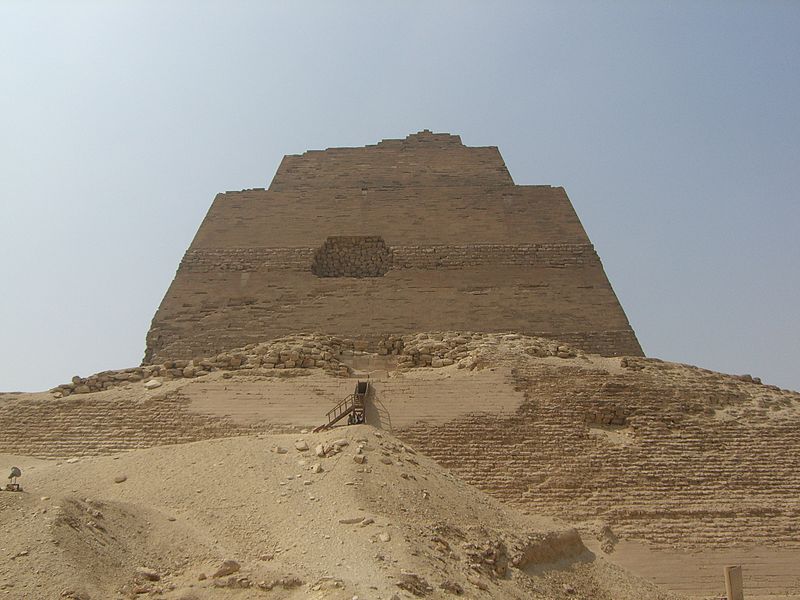 His first attempt at building a pyramid was probably the Meidun pyramid, which seems to have started as a stepped pyramid similar to that of Djoser, but was then covered with limestone blocks to give a smooth outer surface. The burial chamber was built within the pyramid itself, rather than under the pyramid, as previously.
His first attempt at building a pyramid was probably the Meidun pyramid, which seems to have started as a stepped pyramid similar to that of Djoser, but was then covered with limestone blocks to give a smooth outer surface. The burial chamber was built within the pyramid itself, rather than under the pyramid, as previously.
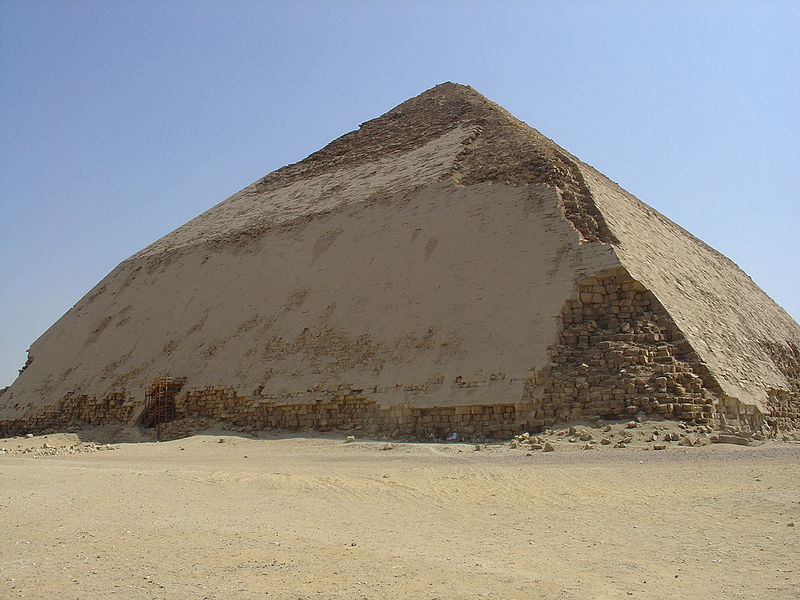 Then came the Bent Pyramid, which was a radical change in construction techniques, and had more passages and chambers within the pyramid itself.
Then came the Bent Pyramid, which was a radical change in construction techniques, and had more passages and chambers within the pyramid itself.
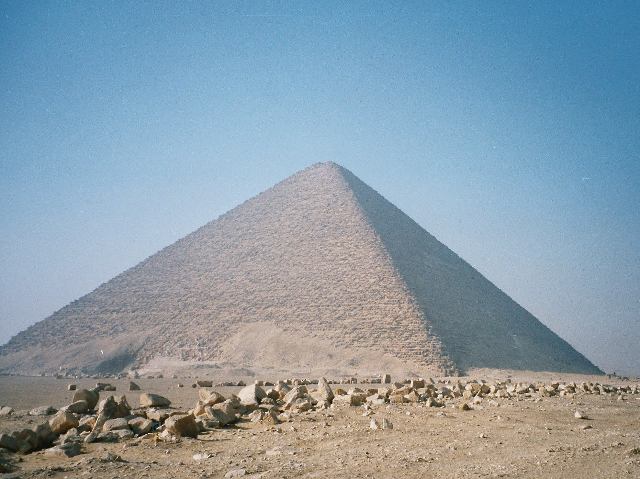 Sneferu's last attempt was the Red Pyramid, in which he achieved the typical smooth outward appearance of a true pyramid. Although its passages and chambers have been explored, no burial chamber or mummy of Sneferu has been found. Sneferu's military expeditions were mainly into Libya and south to Nubia, for slaves and material for his building projects; he does not seem to have regarded Canaan as worthy of plundering.
Sneferu's last attempt was the Red Pyramid, in which he achieved the typical smooth outward appearance of a true pyramid. Although its passages and chambers have been explored, no burial chamber or mummy of Sneferu has been found. Sneferu's military expeditions were mainly into Libya and south to Nubia, for slaves and material for his building projects; he does not seem to have regarded Canaan as worthy of plundering.
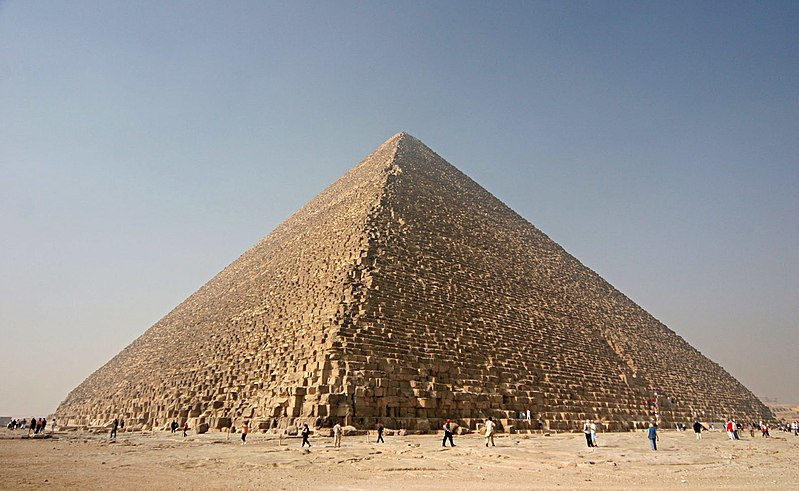 Khufu
Khufu
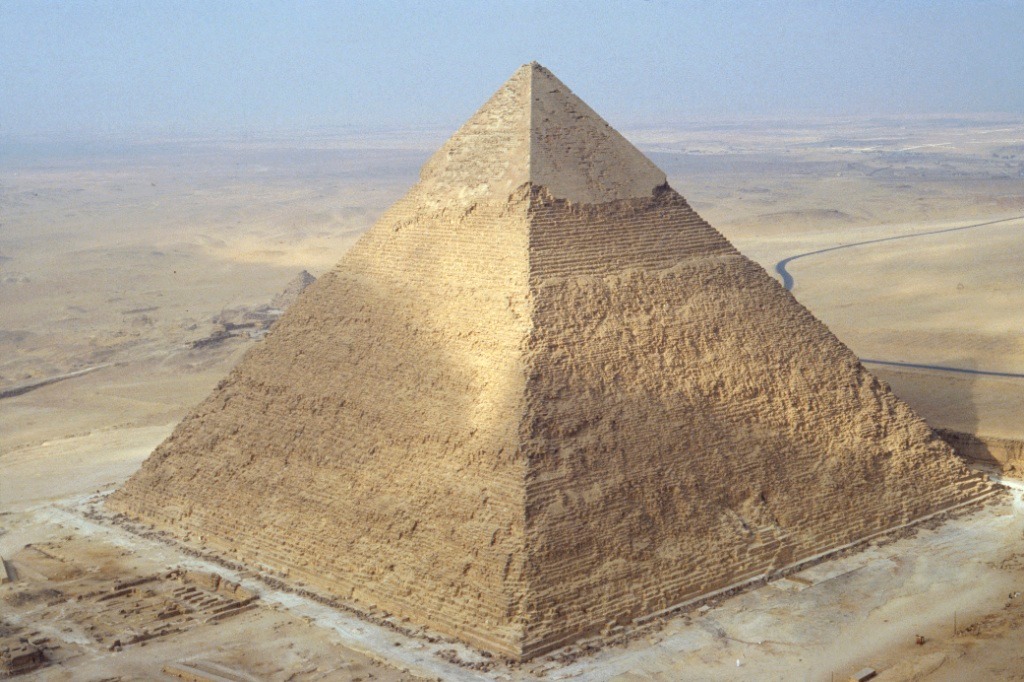 (Cheops) was the son of Sneferu. He built the Great Pyramid at Giza, ca.2550 BC,
(Cheops) was the son of Sneferu. He built the Great Pyramid at Giza, ca.2550 BC,
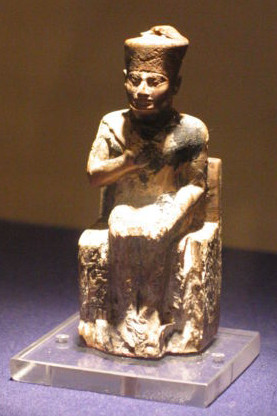 which became one of the Seven Wonders of the ancient world. It was covered with polished white limestone blocks, so that it would shine in the sun. The outer casing has been lost over the centuries, due to deterioration and robbery of the stones - what remains now is the under-layer. Inside the pyramid there are passages and rooms, including the burial chamber for Khufu. Khufu's burial chamber contains an empty sarcophagus made of granite. The walls of the chamber are covered with graffiti from several centuries of tourists.
which became one of the Seven Wonders of the ancient world. It was covered with polished white limestone blocks, so that it would shine in the sun. The outer casing has been lost over the centuries, due to deterioration and robbery of the stones - what remains now is the under-layer. Inside the pyramid there are passages and rooms, including the burial chamber for Khufu. Khufu's burial chamber contains an empty sarcophagus made of granite. The walls of the chamber are covered with graffiti from several centuries of tourists.
Beside the Great Pyramid is a cemetery of much smaller pyramids for members of the royal family, and mastabas for court officials. At one time there were a couple of mortuary temples near the pyramid, but almost no traces of them remain. Khufu also had pits dug to contain his funerary boats - they were disassembled, and buried in pieces. In 1954 one of the boat pits was discovered; it took fourteen years for conservation and reassembly of the boat, which is now displayed in a museum at the site. Excavation of a second boat pit is currently in progress.
Khufu may have built the Sphinx, but this is more often credited to his son Khafre.
Khufu sent expeditions into the Sinai in search of turquoise and copper ore, traded with Biblos for cedar wood for boats, and probably founded a port and harbor at Wadi al-Jarf on the coast of the Red Sea for trade with the Sinai and further south to Punt. In 2013 French archaeologists found hundreds of papyrus fragments at this port, mostly dating to the reign of Khufu. Among them was a diary kept by Merer, who had been an official for the building of the Great pyramid - this gave a great insight into the life of an Egyptian worker of that time.
The practice of Pharaohs marrying their sisters (and later, daughters) had already begun - two of Khufu's daughters were married to their brothers.
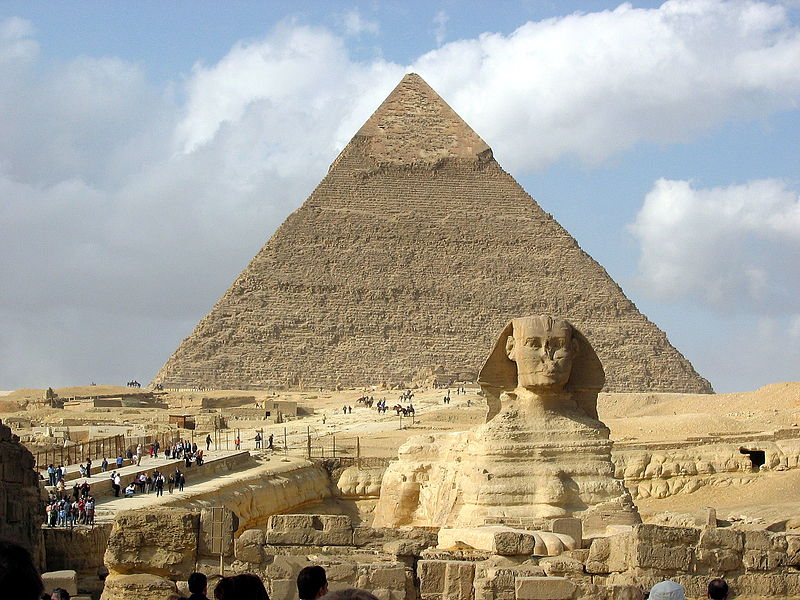 Khafre (Chephren), the son of Kufu, built the second-largest pyramid at Giza, and probably the Sphinx, ca.2500 BC
Khafre (Chephren), the son of Kufu, built the second-largest pyramid at Giza, and probably the Sphinx, ca.2500 BC
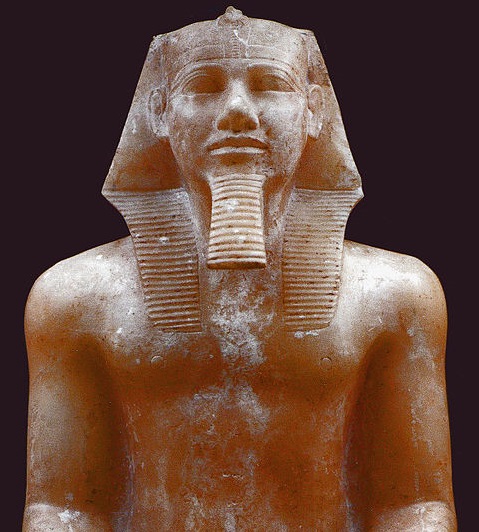
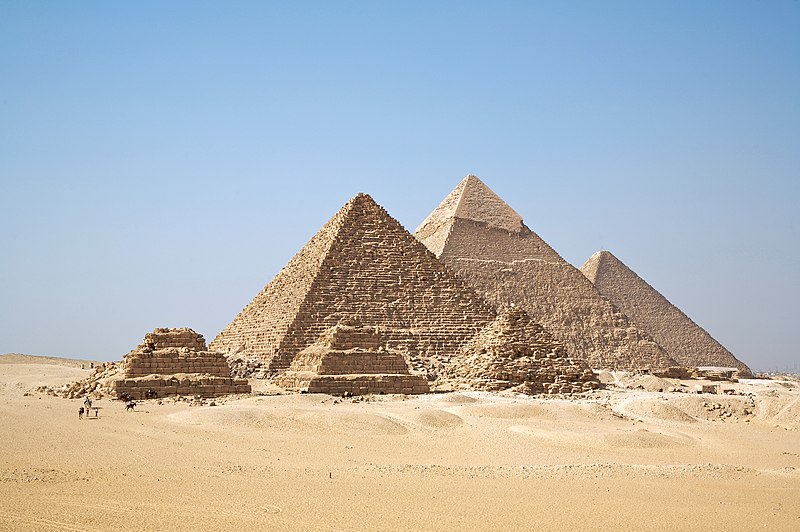 After the great pyramids of Giza the urge to build bigger and bigger pyramids seems to have abated - succeeding kings built smaller pyramids and engaged in other projects.
After the great pyramids of Giza the urge to build bigger and bigger pyramids seems to have abated - succeeding kings built smaller pyramids and engaged in other projects.
Copyright © 1999 Shirley J. Rollinson, all Rights Reserved